Cellular Immune Responses in Rainbow Trout (Onchorhynchus mykiss) Following Vaccination and Challenge Against Salmonid Alphavirus (SAV)
Abstract
1. Introduction
2. Materials and Methods
2.1. Fish
2.2. Treatment Groups
2.3. Vaccination
2.4. Challenge
2.5. Virus Load
2.6. Pathology
2.7. Determination of Cell-Mediated Cytotoxicity (CMC) against SAV Infected Cells
2.7.1. Lactate Dehydrogenase (LDH)-Based Cytotoxicity Assay
2.7.2. Preparation of Target Cells
2.7.3. Preparation of Effector Cells
2.8. Flow Cytometry
2.9. Tissue Sampling, RNA Extraction, cDNA Synthesis and Reverse Transcription Quantitative Polymerase Chain Reaction (RT-qPCR)
Immune Genes
2.10. ELISA
2.11. Statistical Analysis
3. Results
3.1. Virus Load
3.2. Pathology
3.3. Cell-mediated Cytotoxicity (CMC)
3.4. Flow Cytometry
3.5. Gene Expression
3.5.1. PBLs
3.5.2. Spleen
3.6. ELISA
4. Discussion
5. Conclusions
Supplementary Materials
Author Contributions
Funding
Acknowledgments
Conflicts of Interest
Appendix A
References
- Walker, P.J.; Winton, J.R. Emerging viral diseases of fish and shrimp. Veter. Res. 2010, 41, 51. [Google Scholar] [CrossRef]
- Kibenge, F.S.; Godoy, M.G.; Fast, M.; Workenhe, S.; Kibenge, M.J. Countermeasures against viral diseases of farmed fish. Antivir. Res. 2012, 95, 257–281. [Google Scholar] [CrossRef]
- Secombes, C.J.; Wang, T.; Bird, S. The interleukins of fish. Dev. Comp. Immunol. 2011, 35, 1336–1345. [Google Scholar] [CrossRef]
- Uribe, C.; Folch, H.; Enriquez, R.; Moran, G. Innate and adaptive immunity in teleost fish: A review. Veter. Med. 2011, 56, 486–503. [Google Scholar] [CrossRef]
- McLoughlin, M.F.; Graham, D.A. Alphavirus infections in salmonids? A review. J. Fish Dis. 2007, 30, 511–531. [Google Scholar] [CrossRef]
- Rimstad, E. Examples of emerging virus diseases in salmonid aquaculture. Aquac. Res. 2011, 42, 86–89. [Google Scholar] [CrossRef]
- Dhar, A.K.; Manna, S.K.; Allnutt, F.C.T. Viral vaccines for farmed finfish. Virus Dis. 2013, 25, 1–17. [Google Scholar] [CrossRef]
- Biering, E.; Villoing, S.; Sommerset, I.; Christie, K.E. Update on viral vaccines for fish. Dev. Boil. 2005, 121, 97–113. [Google Scholar]
- Romstad, A.B.; Reitan, L.J.; Midtlyng, P.; Gravningen, K.; Evensen, Ø. Antibody responses correlate with antigen dose and in vivo protection for oil-adjuvanted, experimental furunculosis (Aeromonas salmonicida subsp. salmonicida) vaccines in Atlantic salmon (Salmo salar L.) and can be used for batch potency testing of vaccines. Vaccine 2013, 31, 791–796. [Google Scholar] [CrossRef]
- Dahle, M.K.; Jørgensen, J.B. Antiviral defense in salmonids—Mission made possible? Fish Shellfish Immunol. 2019, 87, 421–437. [Google Scholar] [CrossRef]
- Nakanishi, T.; Toda, H.; Shibasaki, Y.; Somamoto, T. Cytotoxic T cells in teleost fish. Dev. Comp. Immunol. 2011, 35, 1317–1323. [Google Scholar] [CrossRef]
- Fischer, U.; Koppang, E.O.; Nakanishi, T. Teleost T and NK cell immunity. Fish Shellfish Immunol. 2013, 35, 197–206. [Google Scholar] [CrossRef]
- Yamaguchi, T.; Takizawa, F.; Furihata, M.; Soto-Lampe, V.; Dijkstra, J.M.; Fischer, U. Teleost cytotoxic T cells. Fish Shellfish Immunol. 2019, 95, 422–439. [Google Scholar] [CrossRef]
- Hasegawa, S.; Nakayasu, C.; Yoshitomi, T.; Nakanishi, T.; Okamoto, N. Specific cell-mediated cytotoxicity against an allogeneic target cell line in isogeneic ginbuna crucian carp. Fish Shellfish Immunol. 1998, 8, 303–313. [Google Scholar] [CrossRef]
- Utke, K.; Bergmann, S.; Lorenzen, N.; Köllner, B.; Ototake, M.; Fischer, U. Cell-mediated cytotoxicity in rainbow trout, Oncorhynchus mykiss, infected with viral haemorrhagic septicaemia virus. Fish Shellfish Immunol. 2007, 22, 182–196. [Google Scholar] [CrossRef]
- Taksdal, T.; Olsen, A.B.; Bjerkås, I.; Hjortaas, M.J.; Dannevig, B.H.; Graham, D.A.; McLoughlin, M.F. Pancreas disease in farmed Atlantic salmon, Salmo salar L., and rainbow trout, Oncorhynchus mykiss (Walbaum), in Norway. J. Fish Dis. 2007, 30, 545–558. [Google Scholar] [CrossRef]
- Jensen, B.B.; Kristoffersen, A.; Myr, C.; Brun, E. Cohort study of effect of vaccination on pancreas disease in Norwegian salmon aquaculture. Dis. Aquat. Org. 2012, 102, 23–31. [Google Scholar] [CrossRef]
- Karlsen, M.; Tingbø, T.; Solbakk, I.-T.; Evensen, Ø.; Furevik, A.; Aas-Eng, A. Efficacy and safety of an inactivated vaccine against Salmonid alphavirus (family Togaviridae). Vaccine 2012, 30, 5688–5694. [Google Scholar] [CrossRef]
- Skjold, P.; Sommerset, I.; Frost, P.; Villoing, S. Vaccination against pancreas disease in Atlantic salmon, Salmo salar L., reduces shedding of salmonid alphavirus. Veter. Res. 2016, 47, 1–6. [Google Scholar] [CrossRef]
- Hodneland, K.; Endresen, C. Sensitive and specific detection of Salmonid alphavirus using real-time PCR (TaqMan®). J. Virol. Methods 2006, 131, 184–192. [Google Scholar] [CrossRef]
- Graham, D.A.; Frost, P.; McLaughlin, K.; Rowley, H.M.; Gabestad, I.; Gordon, A.; McLoughlin, M.F. A comparative study of marine salmonid alphavirus subtypes 1-6 using an experimental cohabitation challenge model. J. Fish Dis. 2011, 34, 273–286. [Google Scholar] [CrossRef]
- Dijkstra, J.M.; Köllner, B.; Aoyagi, K.; Sawamoto, Y.; Kuroda, A.; Ototake, M.; Nakanishi, T.; Fischer, U. The rainbow trout classical MHC class I molecule Onmy-UBA*501 is expressed in similar cell types as mammalian classical MHC class I molecules. Fish Shellfish Immunol. 2003, 14, 1–23. [Google Scholar] [CrossRef]
- Hu, Y.; Maisey, K.; Subramani, P.A.; Liu, F.; Flores-Kossack, C.; Imarai, M.; Secombes, C.J.; Wang, T. Characterisation of rainbow trout peripheral blood leucocytes prepared by hypotonic lysis of erythrocytes, and analysis of their phagocytic activity, proliferation and response to PAMPs and proinflammatory cytokines. Dev. Comp. Immunol. 2018, 88, 104–113. [Google Scholar] [CrossRef] [PubMed]
- Takizawa, F.; Magadan, S.; Parra, D.; Xu, Z.; Korytář, T.; Boudinot, P.; Sunyer, J.O. Novel Teleost CD4-Bearing Cell Populations Provide Insights into the Evolutionary Origins and Primordial Roles of CD4+ Lymphocytes and CD4+ Macrophages. J. Immunol. 2016, 196, 4522–4535. [Google Scholar] [CrossRef]
- Takizawa, F.; Dijkstra, J.M.; Kotterba, P.; Korytář, T.; Kock, H.; Köllner, B.; Jaureguiberry, B.; Nakanishi, T.; Fischer, U. The expression of CD8α discriminates distinct T cell subsets in teleost fish. Dev. Comp. Immunol. 2011, 35, 752–763. [Google Scholar] [CrossRef]
- DeLuca, D.; Wilson, M.; Warr, G.W. Lymphocyte heterogeneity in the trout, Salmo gairdneri, defined with monoclonal antibodies to IgM. Eur. J. Immunol. 1983, 13, 546–551. [Google Scholar] [CrossRef]
- Olsvik, P.; Lie, K.K.; Jordal, A.-E.O.; Nilsen, T.O.; Hordvik, I. Evaluation of potential reference genes in real-time RT-PCR studies of Atlantic salmon. BMC Mol. Biol. 2005, 6, 21. [Google Scholar] [CrossRef]
- Hutornojs, V.; Niedre-Otomere, B.; Kozlovska, T.; Zajakina, A. Comparison of ultracentrifugation methods for concentration of recombinant alphaviruses: Sucrose and iodixanol cushions. Environ. Exp. Biol. 2012, 10, 117–123. [Google Scholar]
- Pfaffl, M.W. A new mathematical model for relative quantification in real-time RT-PCR. Nucleic Acids Res. 2001, 29, e45. [Google Scholar] [CrossRef]
- Lenth, R.V. Least-Squares Means: The R Packagelsmeans. J. Stat. Softw. 2016, 69, 1–33. [Google Scholar] [CrossRef]
- R Development Core Team. R: A Language and Environment for Statistical Computing, 3.6.2 ed.; R Foundation for Statistical Computing: Vienna, Austria, 2019. [Google Scholar]
- Brudeseth, B.E.; Wiulsrød, R.; Fredriksen, B.N.; Lindmo, K.; Løkling, K.-E.; Bordevik, M.; Steine, N.; Klevan, A.; Gravningen, K. Status and future perspectives of vaccines for industrialised fin-fish farming. Fish Shellfish Immunol. 2013, 35, 1759–1768. [Google Scholar] [CrossRef]
- Wang, T.; Liu, F.; Tian, G.; Secombes, C.J.; Wang, T. Lineage/species-specific expansion of the Mx gene family in teleosts: Differential expression and modulation of nine Mx genes in rainbow trout Oncorhynchus mykiss. Fish Shellfish Immunol. 2019, 90, 413–430. [Google Scholar] [CrossRef]
- Collet, B. Innate immune responses of salmonid fish to viral infections. Dev. Comp. Immunol. 2014, 43, 160–173. [Google Scholar] [CrossRef] [PubMed]
- Pichlmair, A.; Sousa, C.R.E. Innate Recognition of Viruses. Immunity 2007, 27, 370–383. [Google Scholar] [CrossRef]
- Collet, B.; Urquhart, K.; Noguera, P.; Larsen, K.H.; Lester, K.; Smail, D.; Bruno, D. A method to measure an indicator of viraemia in Atlantic salmon using a reporter cell line. J. Virol. Methods 2013, 191, 113–117. [Google Scholar] [CrossRef]
- Manicassamy, S.; Pulendran, B. Modulation of adaptive immunity with Toll-like receptors. Semin. Immunol. 2009, 21, 185–193. [Google Scholar] [CrossRef]
- Wang, B.; Fang, Y.; Wu, Y.; Koga, K.; Osuga, Y.; Lv, S.; Chen, D.; Zhu, Y.; Wang, J.; Huang, H. Viperin is induced following toll-like receptor 3 (TLR3) ligation and has a virus-responsive function in human trophoblast cells. Placenta 2015, 36, 667–673. [Google Scholar] [CrossRef]
- Herath, T.K.; Bron, J.E.; Thompson, K.; Taggart, J.B.; Adams, A.; Ireland, J.H.; Richards, R.H. Transcriptomic analysis of the host response to early stage salmonid alphavirus (SAV-1) infection in Atlantic salmon Salmo salar L. Fish Shellfish. Immunol. 2012, 32, 796–807. [Google Scholar] [CrossRef]
- Xu, C.; Guo, T.-C.; Mutoloki, S.; Haugland, Ø.; Evensen, Ø. Gene expression studies of host response to Salmonid alphavirus subtype 3 experimental infections in Atlantic salmon. Veter. Res. 2012, 43, 78. [Google Scholar] [CrossRef]
- Chang, M.; Collet, B.; Nie, P.; Lester, K.; Campbell, S.; Secombes, C.J.; Zou, J. Expression and Functional Characterization of the RIG-I-Like Receptors MDA5 and LGP2 in Rainbow Trout (Oncorhynchus mykiss). J. Virol. 2011, 85, 8403–8412. [Google Scholar] [CrossRef]
- Fischer, U.; Utke, K.; Somamoto, T.; Köllner, B.; Ototake, M.; Nakanishi, T. Cytotoxic activities of fish leucocytes. Fish Shellfish Immunol. 2006, 20, 209–226. [Google Scholar] [CrossRef] [PubMed]
- Somamoto, T.; Koppang, E.O.; Fischer, U. Antiviral functions of CD8+ cytotoxic T cells in teleost fish. Dev. Comp. Immunol. 2014, 43, 197–204. [Google Scholar] [CrossRef]
- Fischer, U.; Ototake, M.; Nakanishi, T. Life span of circulating blood cells in ginbuna crucian carp (Carassius auratus langsdorfii). Fish Shellfish Immunol. 1998, 8, 339–349. [Google Scholar] [CrossRef]
- Somamoto, T.; Nakanishi, T.; Okamoto, N. Role of Specific Cell-Mediated Cytotoxicity in Protecting Fish from Viral Infections. Virology 2002, 297, 120–127. [Google Scholar] [CrossRef]
- Grove, S.; Austbø, L.; Hodneland, K.; Frost, P.; Løvoll, M.; McLoughlin, M.; Thim, H.; Braaen, S.; König, M.; Syed, M.; et al. Immune parameters correlating with reduced susceptibility to pancreas disease in experimentally challenged Atlantic salmon (Salmo salar). Fish Shellfish Immunol. 2013, 34, 789–798. [Google Scholar] [CrossRef]
- Sato, A.; Okamoto, N. Induction of virus-specific cell-mediated cytotoxic responses of isogeneic ginbuna crucian carp, after oral immunization with inactivated virus. Fish Shellfish Immunol. 2010, 29, 414–421. [Google Scholar] [CrossRef]
- Utke, K.; Kock, H.; Schuetze, H.; Bergmann, S.M.; Lorenzen, N.; Einer-Jensen, K.; Köllner, B.; Dalmo, R.A.; Vesely, T.; Ototake, M.; et al. Cell-mediated immune responses in rainbow trout after DNA immunization against the viral hemorrhagic septicemia virus. Dev. Comp. Immunol. 2008, 32, 239–252. [Google Scholar] [CrossRef]
- Hetland, D.L.; Dale, O.B.; Skjødt, K.; Press, C.M.; Falk, K. Depletion of CD8 alpha cells from tissues of Atlantic salmon during the early stages of infection with high or low virulent strains of infectious salmon anaemia virus (ISAV). Dev. Comp. Immunol. 2011, 35, 817–826. [Google Scholar] [CrossRef]
- Xu, C.; Evensen, Ø.; Munang’Andu, H.M. Transcriptome Analysis Shows That IFN-I Treatment and Concurrent SAV3 Infection Enriches MHC-I Antigen Processing and Presentation Pathways in Atlantic Salmon-Derived Macrophage/Dendritic Cells. Viruses 2019, 11, 464. [Google Scholar] [CrossRef]
- Vivier, E.; Raulet, D.H.; Moretta, A.; Caligiuri, M.A.; Zitvogel, L.; Lanier, L.L.; Yokoyama, W.M.; Ugolini, S. Innate or Adaptive Immunity? The Example of Natural Killer Cells. Science 2011, 331, 44–49. [Google Scholar] [CrossRef]
- Sasaki, Y.; Maita, M.; Okamoto, N. Rainbow trout neutrophils are responsible for non-specific cytotoxicity. Fish Shellfish Immunol. 2002, 12, 243–252. [Google Scholar] [CrossRef]
- Pahl, J.H.W.; Cerwenka, A.; Ni, J. Memory-Like NK Cells: Remembering a Previous Activation by Cytokines and NK Cell Receptors. Front. Immunol. 2018, 9. [Google Scholar] [CrossRef]
- Sun, J.C.; Lanier, L.L. Is There Natural Killer Cell Memory and Can It Be Harnessed by Vaccination? Cold Spring Harb. Perspect. Biol. 2017, 10, a029538. [Google Scholar] [CrossRef]
- Ashfaq, H.; Soliman, H.; Saleh, M.; El-Matbouli, M. CD4: A vital player in the teleost fish immune system. Veter. Res. 2019, 50, 1–11. [Google Scholar] [CrossRef]
- Steinman, L. A brief history of TH17, the first major revision in the TH1/TH2 hypothesis of T cell–mediated tissue damage. Nat. Med. 2007, 13, 139–145. [Google Scholar] [CrossRef]
- Schroder, K.; Hertzog, P.J.; Ravasi, T.; Hume, D.A. Interferon-γ: An overview of signals, mechanisms and functions. J. Leukoc. Biol. 2003, 75, 163–189. [Google Scholar] [CrossRef]
- Sun, B.; Skjaeveland, I.; Svingerud, T.; Zou, J.; Jørgensen, J.; Robertsen, B. Antiviral Activity of Salmonid Gamma Interferon against Infectious Pancreatic Necrosis Virus and Salmonid Alphavirus and Its Dependency on Type I Interferon. J. Virol. 2011, 85, 9188–9198. [Google Scholar] [CrossRef]
- Cuesta, A.; Chaves-Pozo, E. (Elena); Heras, A.D.L.; Saint-Jean, S.R.; Pérez-Prieto, S.; Tafalla, C. An active DNA vaccine against infectious pancreatic necrosis virus (IPNV) with a different mode of action than fish rhabdovirus DNA vaccines. Vaccine 2010, 28, 3291–3300. [Google Scholar] [CrossRef]
- Cuesta, A.; Tafalla, C. Transcription of immune genes upon challenge with viral hemorrhagic septicemia virus (VHSV) in DNA vaccinated rainbow trout (Oncorhynchus mykiss). Vaccine 2009, 27, 280–289. [Google Scholar] [CrossRef]
- Thim, H.L.; Villoing, S.; McLoughlin, M.; Christie, K.E.; Grove, S.; Frost, P.; Jørgensen, J.B. Vaccine Adjuvants in Fish Vaccines Make a Difference: Comparing Three Adjuvants (Montanide ISA763A Oil, CpG/Poly I:C Combo and VHSV Glycoprotein) Alone or in Combination Formulated with an Inactivated Whole Salmonid Alphavirus Antigen. Vaccines 2014, 2, 228–251. [Google Scholar] [CrossRef]
- Wang, T.; Johansson, P.; Abós, B.; Holt, A.; Tafalla, C.; Jiang, Y.; Wang, A.; Xu, Q.; Qi, Z.; Huang, W.; et al. First in-depth analysis of the novel Th2-type cytokines in salmonid fish reveals distinct patterns of expression and modulation but overlapping bioactivities. Oncotarget 2016, 7, 10917–10946. [Google Scholar] [CrossRef]
- Loughlin, M.; Rowley, D. A serological survey of salmon pancreas disease virus (SPDV) antibodies in farmed Atlantic salmon, Salmo salar L. J. Fish Dis. 1998, 21, 305–307. [Google Scholar] [CrossRef]
- López-Dóriga, M.; Smail, D.; Smith, R.; Doménech, A.; Castric, J.; Smith, P.; Ellis, A. Isolation of salmon pancreas disease virus (SPDV) in cell culture and its ability to protect against infection by the ‘wild-type’ agent. Fish Shellfish Immunol. 2001, 11, 505–522. [Google Scholar] [CrossRef]
- Desvignes, L.; Quentel, C.; Lamour, F.; Le Ven, A. Pathogenesis and immune response in Atlantic salmon (Salmo salar L.) parr experimentally infected with salmon pancreas disease virus (SPDV). Fish Shellfish Immunol. 2002, 12, 77–95. [Google Scholar] [CrossRef]
- Thim, H.L.; Iliev, D.B.; Christie, K.E.; Villoing, S.; McLoughlin, M.F.; Strandskog, G.; Jørgensen, J.B. Immunoprotective activity of a Salmonid Alphavirus Vaccine: Comparison of the immune responses induced by inactivated whole virus antigen formulations based on CpG class B oligonucleotides and poly I:C alone or combined with an oil adjuvant. Vaccine 2012, 30, 4828–4834. [Google Scholar] [CrossRef]
- Hussell, T.; Goulding, J. Structured regulation of inflammation during respiratory viral infection. Lancet Infect. Dis. 2010, 10, 360–366. [Google Scholar] [CrossRef]
- Peddie, S.; Mclauchlan, P.E.; Ellis, A.E.; Secombes, C.J. Effect of intraperitoneally administered IL-1b-derived peptides on resistance to viral haemorrhagic septicaemia in rainbow trout Oncorhynchus mykiss. Dis. Aquat. Org. 2003, 56, 195–200. [Google Scholar] [CrossRef]
- Mutoloki, S.; Alexandersen, S.; Evensen, Ø. Sequential study of antigen persistence and concomitant inflammatory reactions relative to side-effects and growth of Atlantic salmon (Salmo salar L.) following intraperitoneal injection with oil-adjuvanted vaccines. Fish Shellfish Immunol. 2004, 16, 633–644. [Google Scholar] [CrossRef]
- Mutoloki, S.; Reite, O.B.; Brudeseth, B.; Tverdal, A.; Evensen, Ø. A comparative immunopathological study of injection site reactions in salmonids following intraperitoneal injection with oil-adjuvanted vaccines. Vaccine 2006, 24, 578–588. [Google Scholar] [CrossRef]
- Mutoloki, S.; Cooper, G.A.; Marjara, I.S.; Koop, B.F.; Evensen, Ø. High gene expression of inflammatory markers and IL-17A correlates with severity of injection site reactions of Atlantic salmon vaccinated with oil-adjuvanted vaccines. BMC Genom. 2010, 11, 336. [Google Scholar] [CrossRef]
- Veenstra, K.A.; Wang, T.; Alnabulsi, A.; Douglas, A.; Russell, S.; Tubbs, L.; Ben Arous, J.; Secombes, C.J. Analysis of adipose tissue immune gene expression after vaccination of rainbow trout with adjuvanted bacterins reveals an association with side effects. Mol. Immunol. 2017, 88, 89–98. [Google Scholar] [CrossRef]
- Johansson, P.; Wang, T.; Collet, B.; Corripio-Miyar, Y.; Monte, M.M.; Secombes, C.J.; Zou, J. Identification and expression modulation of a C-type lectin domain family 4 homologue that is highly expressed in monocytes/macrophages in rainbow trout (Oncorhynchus mykiss). Dev. Comp. Immunol. 2016, 54, 55–65. [Google Scholar] [CrossRef]
- Veenstra, K.A.; Alnabulsi, A.; Tubbs, L.; Ben Arous, J.; Secombes, C.J. Immunohistochemical examination of immune cells in adipose tissue of rainbow trout (Oncorhynchus mykiss) following intraperitoneal vaccination. Fish Shellfish Immunol. 2019, 87, 559–564. [Google Scholar] [CrossRef]
- Dijkstra, J.M.; Fischer, U.; Sawamoto, Y.; Ototake, M.; Nakanishi, T. Exogenous antigens and the stimulation of MHC class I restricted cell-mediated cytotoxicity: Possible strategies for fish vaccines. Fish Shellfish Immunol. 2001, 11, 437–458. [Google Scholar] [CrossRef]
- Øverland, H.S.; Pettersen, E.F.; Rønneseth, A.; Wergeland, H.I. Phagocytosis by B-cells and neutrophils in Atlantic salmon (Salmo salar L.) and Atlantic cod (Gadus morhua L.). Fish Shellfish Immunol. 2010, 28, 193–204. [Google Scholar] [CrossRef]
- Jenberie, S.; Thim, H.L.; Sunyer, J.O.; Skjødt, K.; Jensen, I.; Jørgensen, J.B. Profiling Atlantic salmon B cell populations: CpG-mediated TLR-ligation enhances IgM secretion and modulates immune gene expression. Sci. Rep. 2018, 8, 1–12. [Google Scholar] [CrossRef]
- Toda, H.; Shibasaki, Y.; Koike, T.; Ohtani, M.; Takizawa, F.; Ototake, M.; Moritomo, T.; Nakanishi, T. Alloantigen-specific killing is mediated by CD8-positive T cells in fish. Dev. Comp. Immunol. 2009, 33, 646–652. [Google Scholar] [CrossRef]
- Rodriguez, M.F.; Wiens, G.D.; Purcell, M.K.; Palti, Y. Characterization of Toll-like receptor 3 gene in rainbow trout (Oncorhynchus mykiss). Immunogenetics 2005, 57, 510–519. [Google Scholar] [CrossRef]
- Mourich, D.; Hansen, J.; Leong, J. Natural killer cell enhancement factor-like gene in rainbow trout (Oncorhynchus mykiss). Immunogenetics 1995, 42, 438–439. [Google Scholar] [CrossRef]
- Wang, T.; Bols, N.; Secombes, C.J. Cloning and Modulation of Rainbow Trout Macrophage Colony-Stimulating Factor Receptor Gene in RTS-11, Monocyte/Macrophage Cell Line. 2001. Available online: https://www.ncbi.nlm.nih.gov/nuccore/AJ417832.1/ (accessed on 20 March 2019).
- Athanasopoulou, S.; Marioli, D.; Mikrou, A.; Papanastasiou, A.D.; Zarkadis, I.K. Cloning and characterization of the trout perforin. Fish Shellfish Immunol. 2009, 26, 908–912. [Google Scholar] [CrossRef]
- Husain, M.; Bird, S.; Van Zwieten, R.; Secombes, C.J.; Wang, T. Cloning of the IL-1β3 gene and IL-1β4 pseudogene in salmonids uncovers a second type of IL-1β gene in teleost fish. Dev. Comp. Immunol. 2012, 38, 431–446. [Google Scholar] [CrossRef]
- Tafalla, C.; Chico, V.; Perez, L.; Coll, J.; Estepa, A. In vitro and in vivo differential expression of rainbow trout (Oncorhynchus mykiss) Mx isoforms in response to viral haemorrhagic septicaemia virus (VHSV) G gene, poly I:C and VHSV. Fish Shellfish Immunol. 2007, 23, 210–221. [Google Scholar] [CrossRef]
- Boudinot, P.; Massin, P.; Blanco, M.; Riffault, S.; Benmansour, A. vig-1, a New Fish Gene Induced by the Rhabdovirus Glycoprotein, Has a Virus-Induced Homologue in Humans and Shares Conserved Motifs with the MoaA Family. J. Virol. 1999, 73, 1846–1852. [Google Scholar] [CrossRef]
- Zou, J.; Carrington, A.; Collet, B.; Dijkstra, J.M.; Yoshiura, Y.; Bols, N.; Secombes, C. Identification and Bioactivities of IFN-γ in Rainbow Trout Oncorhynchus mykiss: The First Th1-Type Cytokine Characterized Functionally in Fish. J. Immunol. 2005, 175, 2484–2494. [Google Scholar] [CrossRef]
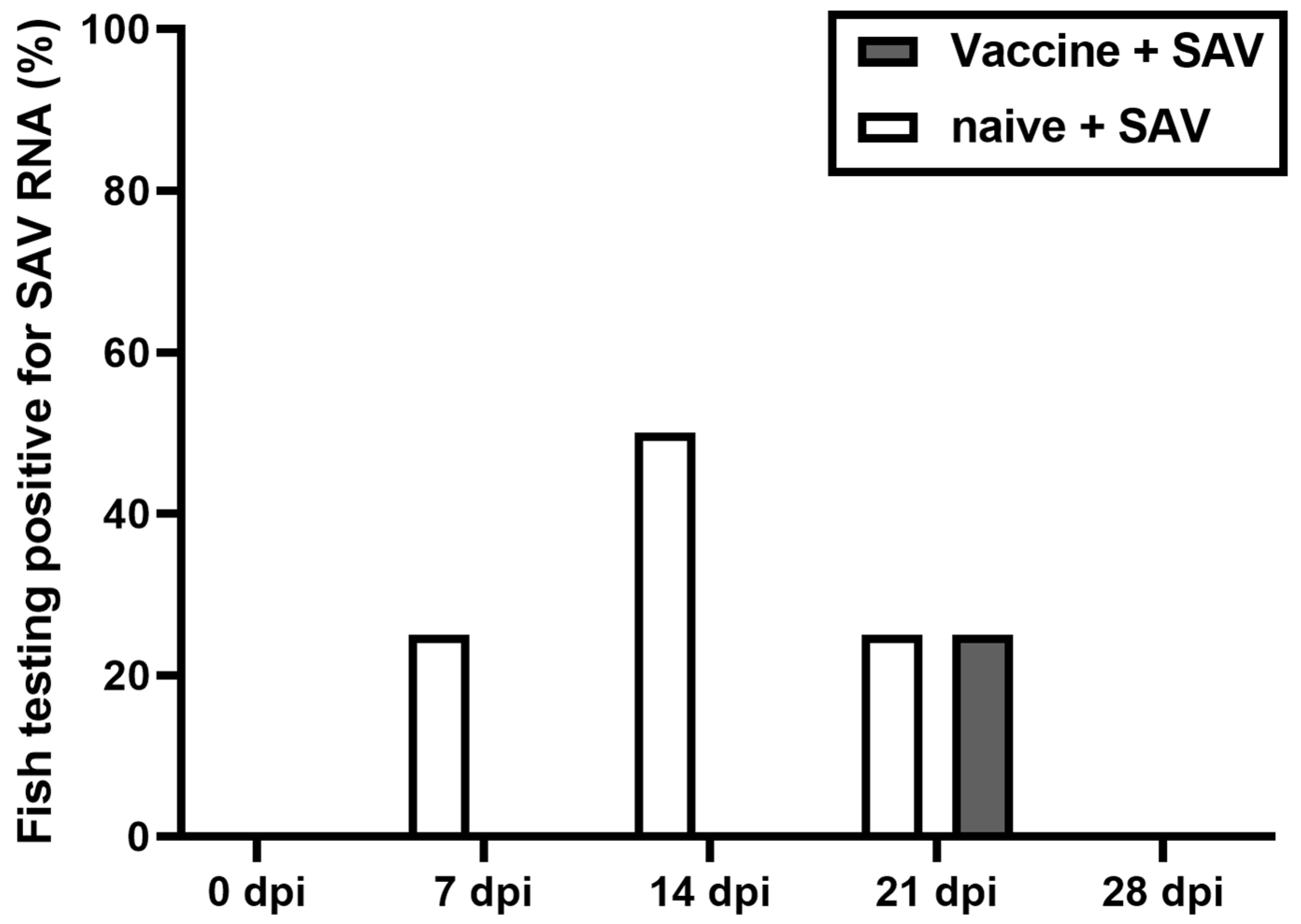
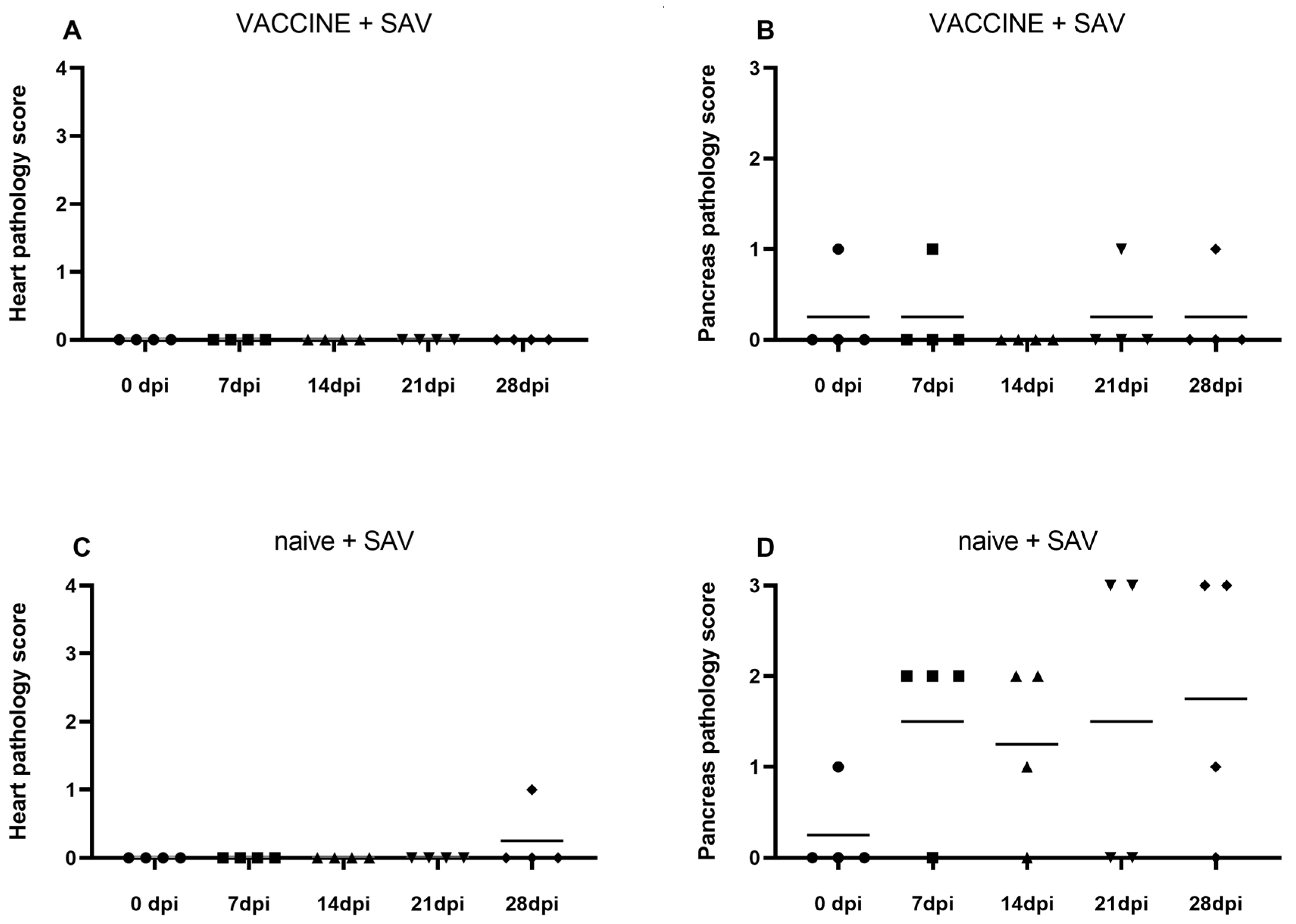
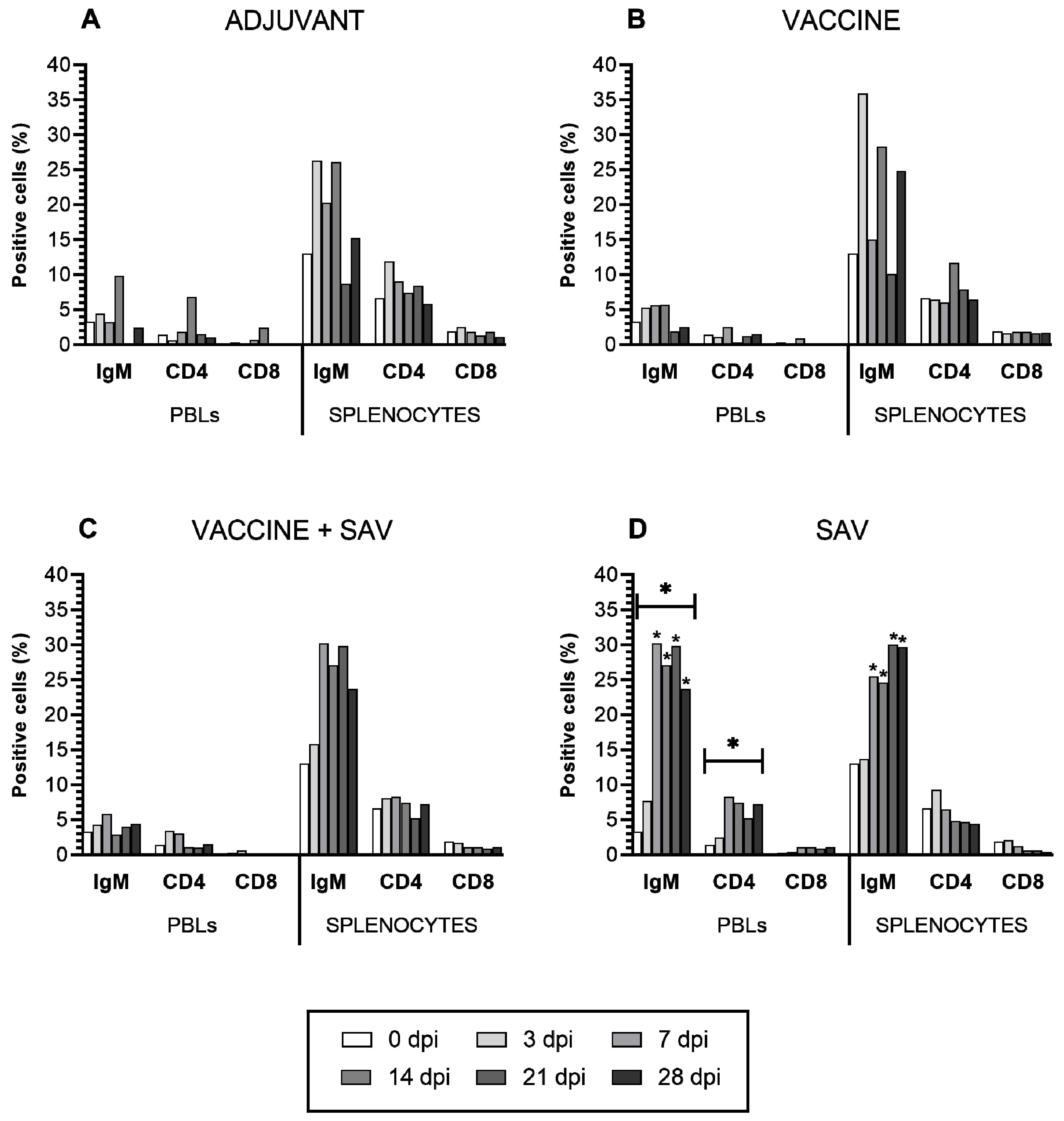
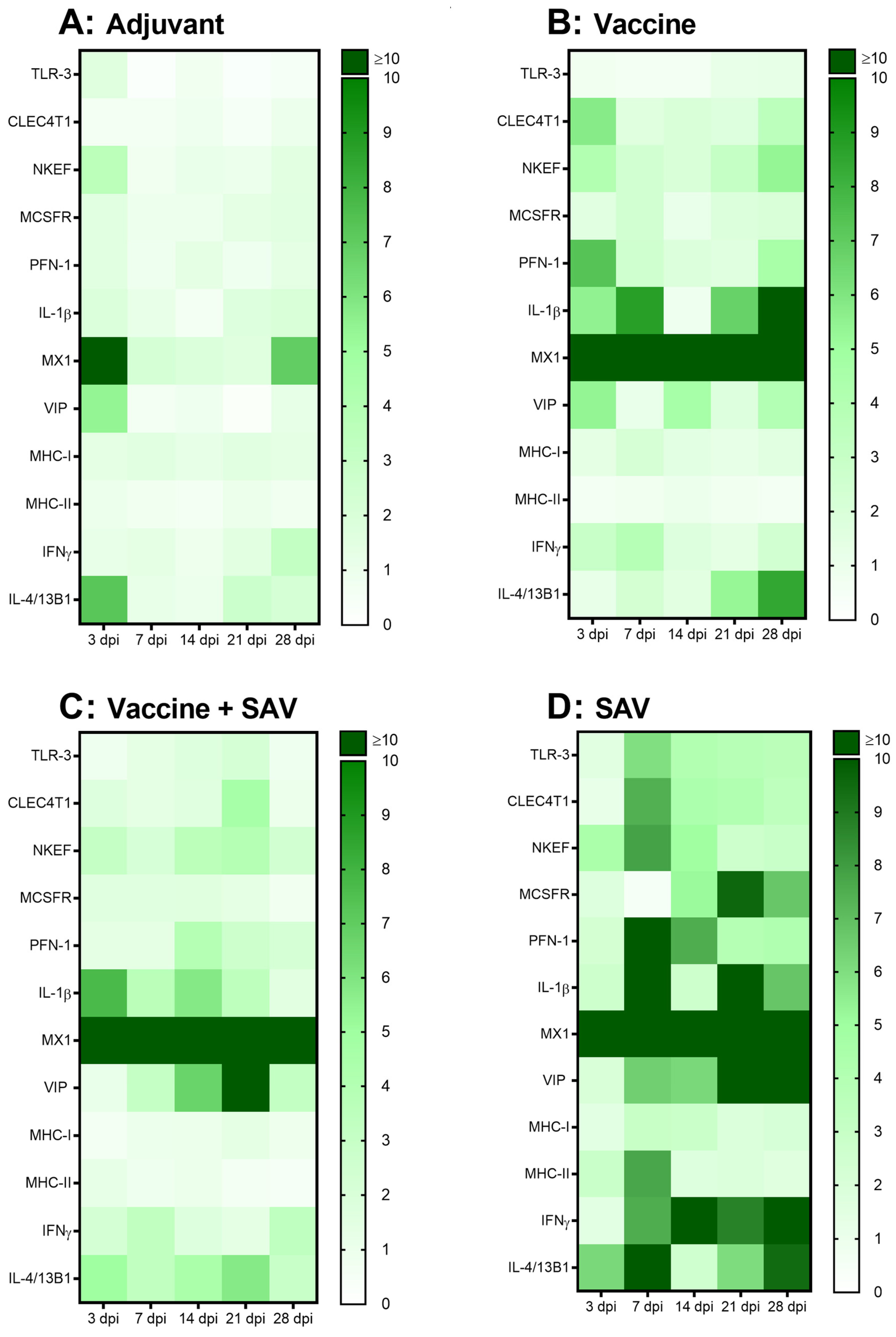
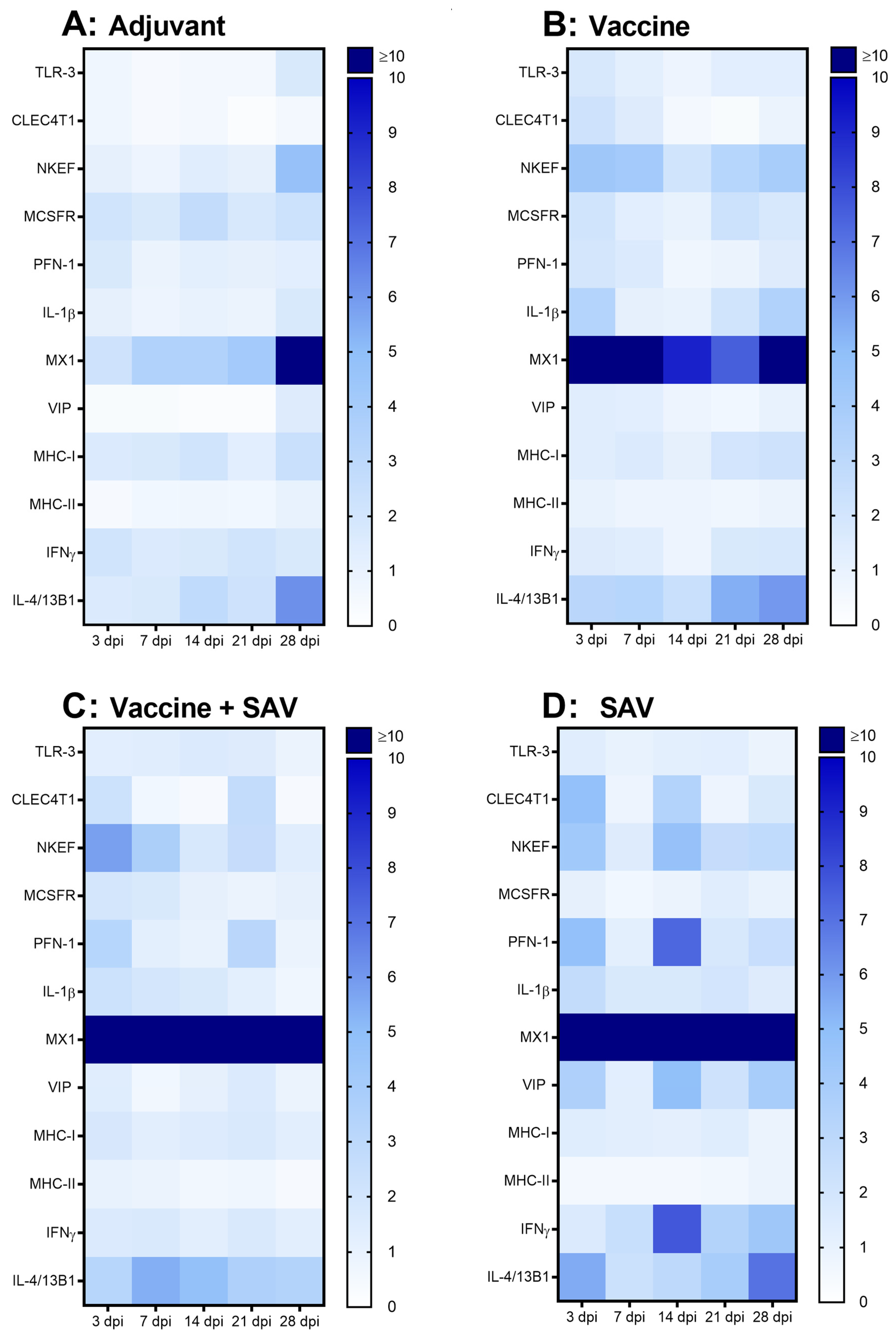
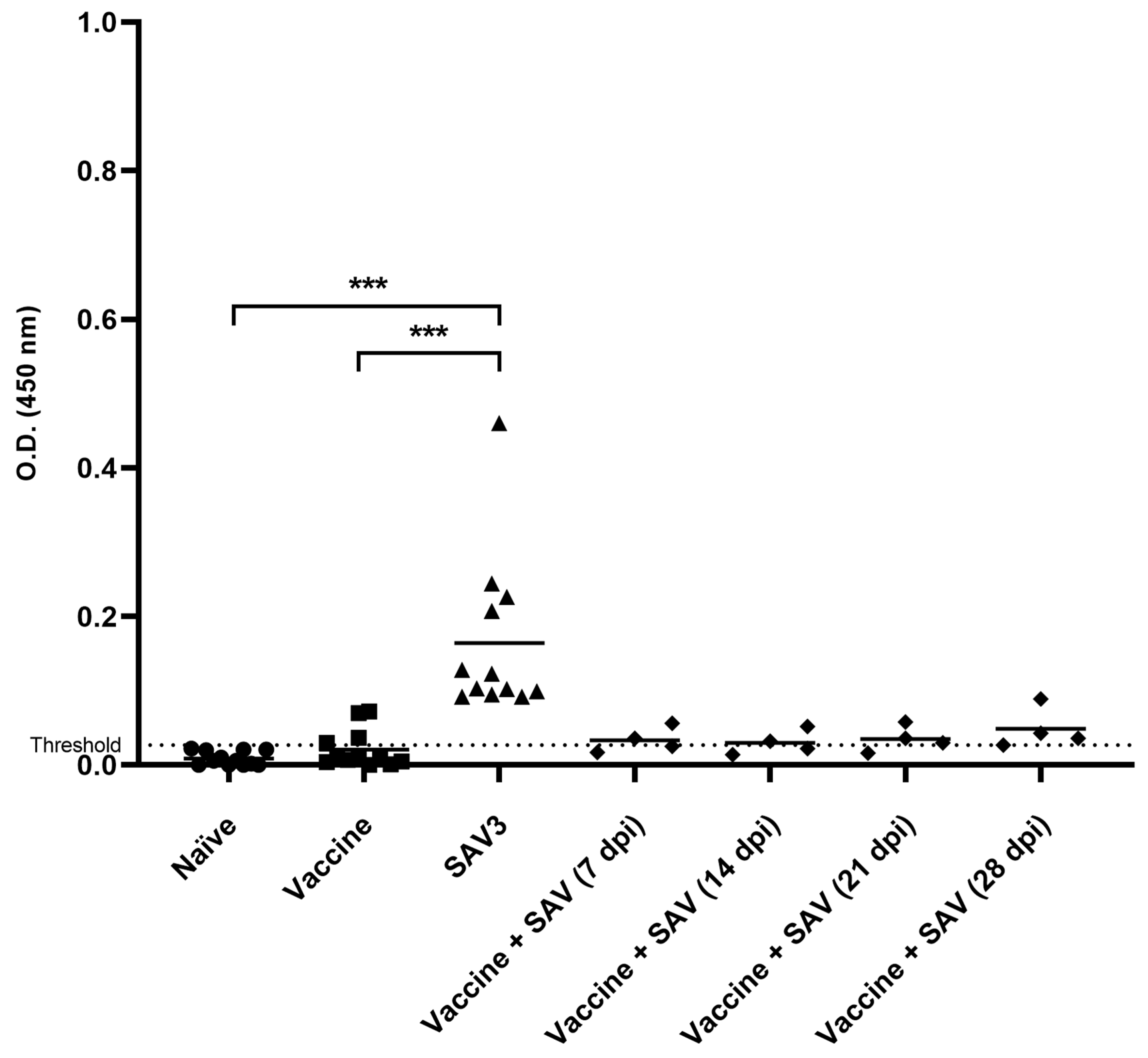
| Group | Treatment * | Time Points * Sampled | Tissues Sampled | Assessment | |
|---|---|---|---|---|---|
| 1 | adjuvant | - | 0, 3, 7, 14, 21, 28 dpv | blood, spleen | CMC, flow cytometry, RT-qPCR, |
| 2 | vaccine | - | 0, 3, 7, 14, 21, 28, 63 dpv | heart, pancreas, blood, spleen | histology, CMC, flow cytometry, RT-qPCR, ELISA |
| 3 | vaccine | SAV3 challenge 43 dpv | 0, 3, 7, 14, 21, 28 dpi | heart, pancreas, blood, spleen | histology, virus load, CMC, flow cytometry, RT-qPCR, ELISA |
| 4 | - | SAV3 challenge | 0, 3, 7, 14, 21, 28, 63 dpi | heart, pancreas, blood, spleen | histology, virus load, CMC, flow cytometry, RT-qPCR, ELISA |
| Primary Antibody (Monoclonal Antibody Against Trout Molecules) | Reference | Dilution | Secondary Antibody | Dilution |
|---|---|---|---|---|
| CD4 (clones 4-1(6) & 4-2b) | [24] | 1:50 | goat anti-rat IgG ALEXA 488 | 1:700 |
| CD8α (clone 7a8c) | [25] | 1:50 | goat anti-rat IgG ALEXA 488 | 1:700 |
| IgM (clone 1.14) | [26] | 1:200 | goat anti-mouse IgG, IgM ALEXA 488 | 1:800 |
| A | B | |||||||||||
| ADJUVANT | VACCINE | |||||||||||
| PBLs | SPLENOCYTES | PBLs | SPLENOCYTES | |||||||||
| MHC-I mismatched | MHC-I matched | MHC-I mismatched | MHC-I matched | MHC-I mismatched | MHC-I matched | MHC-I mismatched | MHC-I matched | |||||
| 0 dpv | non-infected target cells | 0 | 0 | 0 | 0 | 0 dpv | non-infected target cells | 0 | 0 | 0 | 0 | |
| 3 dpv | 0 | 0 | 0 | 0 | 3 dpv | 0 | 0 | 0 | 0 | |||
| 7 dpv | 6 | 0 | 7 | 0 | 7 dpv | 0 | 0 | 0 | 0 | |||
| 14 dpv | 8 | 14 | 17 | 11 | 14 dpv | 0 | 0 | 0 | 0 | |||
| 21 dpv | 4 | 0 | 4 | 0 | 21 dpv | 6 | 0 | 9 | 0 | |||
| 28 dpv | 0 | 0 | 0 | 0 | 28 dpv | 0 | 0 | 0 | 0 | |||
| 0 dpv | infected target cells | 4 | 9 | 0 | 5 | 0 dpv | infected target cells | 4 | 9 | 0 | 5 | |
| 3 dpv | 0 | 12 | 0 | 10 | 3 dpv | 14 | 13 | 11 | 13 | |||
| 7 dpv | 8 | 8 | 10 | 10 | 7 dpv | 5 | 3 | 11 | 0 | |||
| 14 dpv | 21 | 24 | 19 | 9 | 14 dpv | 0 | 7 | 0 | 0 | |||
| 21 dpv | 6 | 4 | 8 | 0 | 21 dpv | 0 | 0 | 4 | 0 | |||
| 28 dpv | 0 | 0 | 0 | 0 | 28 dpv | 24 | 0 | 14 | 0 | |||
| C | D | |||||||||||
| VACCINE + SAV | naïve + SAV | |||||||||||
| PBLs | SPLEENOCYTES | PBLs | SPLEENOCYTES | |||||||||
| MHC-I mismatched | MHC-I matched | MHC-I mismatched | MHC-I matched | MHC-I mismatched | MHC-I matched | MHC-I mismatched | MHC-I matched | |||||
| 0 dpi | non-infected target cells | 0 | 0 | 0 | 0 | 0 dpi | non-infected target cells | 0 | 0 | 0 | 0 | |
| 3 dpi | 0 | 0 | 0 | 0 | 3 dpi | 0 | 0 | 0 | 0 | |||
| 7 dpi | 0 | 4 | 0 | 0 | 7 dpi | 0 | 0 | 0 | 0 | |||
| 14 dpi | 0 | 0 | 0 | 0 | 14 dpi | 0 | 0 | 0 | 0 | |||
| 21 dpi | 0 | 0 | 0 | 0 | 21 dpi | 0 | 0 | 0 | 0 | |||
| 28 dpi | 0 | 0 | 0 | 0 | 28 dpi | 0 | 0 | 0 | 0 | |||
| 0 dpi | infected target cells | 4 | 9 | 0 | 5 | 0 dpi | infected target cells | 4 | 9 | 0 | 5 | |
| 3 dpi | 0 | 12 | 3 | 8 | 3 dpi | 0 | 0 | 0 | 0 | |||
| 7 dpi | 17 | 32 | 15 | 19 | 7 dpi | 0 | 13 | 5 | 3 | |||
| 14 dpi | 18 | 14 | 17 | 10 | 14 dpi | 0 | 5 | 1 | 3 | |||
| 21 dpi | 0 | 26 | 4 | 8 | 21 dpi | 9 | 33 | 11 | 27 | |||
| 28 dpi | 9 | 10 | 8 | 9 | 28 dpi | 3 | 4 | 0 | 0 | |||
Publisher’s Note: MDPI stays neutral with regard to jurisdictional claims in published maps and institutional affiliations. |
© 2020 by the authors. Licensee MDPI, Basel, Switzerland. This article is an open access article distributed under the terms and conditions of the Creative Commons Attribution (CC BY) license (http://creativecommons.org/licenses/by/4.0/).
Share and Cite
Veenstra, K.A.; Hodneland, K.; Fischer, S.; Takehana, K.; Belmonte, R.; Fischer, U. Cellular Immune Responses in Rainbow Trout (Onchorhynchus mykiss) Following Vaccination and Challenge Against Salmonid Alphavirus (SAV). Vaccines 2020, 8, 725. https://doi.org/10.3390/vaccines8040725
Veenstra KA, Hodneland K, Fischer S, Takehana K, Belmonte R, Fischer U. Cellular Immune Responses in Rainbow Trout (Onchorhynchus mykiss) Following Vaccination and Challenge Against Salmonid Alphavirus (SAV). Vaccines. 2020; 8(4):725. https://doi.org/10.3390/vaccines8040725
Chicago/Turabian StyleVeenstra, Kimberly A., Kjartan Hodneland, Susanne Fischer, Kota Takehana, Rodrigo Belmonte, and Uwe Fischer. 2020. "Cellular Immune Responses in Rainbow Trout (Onchorhynchus mykiss) Following Vaccination and Challenge Against Salmonid Alphavirus (SAV)" Vaccines 8, no. 4: 725. https://doi.org/10.3390/vaccines8040725
APA StyleVeenstra, K. A., Hodneland, K., Fischer, S., Takehana, K., Belmonte, R., & Fischer, U. (2020). Cellular Immune Responses in Rainbow Trout (Onchorhynchus mykiss) Following Vaccination and Challenge Against Salmonid Alphavirus (SAV). Vaccines, 8(4), 725. https://doi.org/10.3390/vaccines8040725





